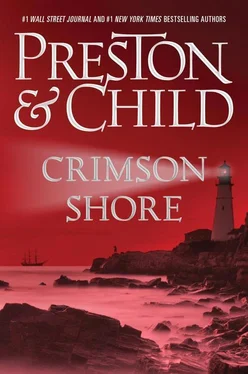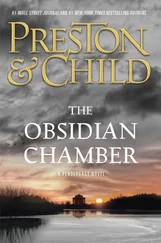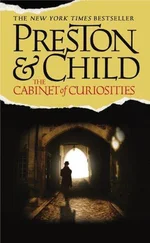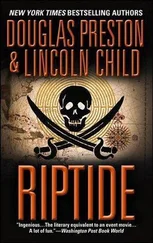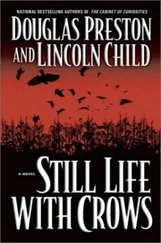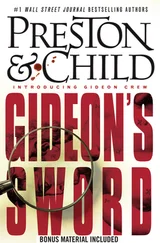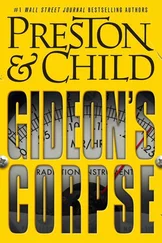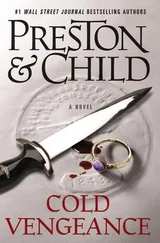In the middle of the floor, she noticed an unusually large gap between two of the boards. She knelt once again, removing the antique Italian Maniago stiletto she had recently begun keeping on her person. A press of the trigger set into the mother-of-pearl handle released the small, slim blade.
A brief interval of probing at the gap made it clear the boards were securely fastened.
The bed had a skirt that fell almost to the floor. But its lower trim was dusty and obviously undisturbed; nothing had been stored beneath.
Now Constance rose once more and went over to the rolltop desk. It had four small drawers in its top, two on each side, and four larger drawers beneath. One after the other, she pulled out the small upper drawers — full of faded Exmouth postcards and writing paper adorned with sketches of the Inn — and looked behind them. Nothing but sawdust and the traceries of spiderwebs. Next she began pulling out the larger drawers beneath the desktop, placing them on the floor one at a time, examining their contents with the flashlight, then probing the resulting cavities with her flashlight and feeling along the upper edges.
As she pulled out the lower-right drawer, a quiet thud sounded from the recesses behind. Quickly, she shone her light inside. Two items — the thin leather notebook and a periodical of some kind — had been hidden there, placed on end behind the closed drawer. She removed them, replaced the drawer, then took a seat on the bed to examine her find.
What she thought had been a periodical was, in fact, an auction catalog from Christie’s of London. It dated to August of two years before, and was titled Magnificent Jewels from a Noble Estate . While a few entries had been indicated by bookmarks, there were no notes or jottings of any kind.
Constance frowned a moment, glancing at the cover of the catalog, thinking. Then she put it to one side, opened the worn leather journal, and began leafing through the pages of crabbed, tiny handwriting. At one page she stopped and began reading intently.
March 5
I spent the morning and much of the afternoon in Warwickshire, visiting Hurwell Ossory. What a time I had of it! The Hurwells are a type of ancient English family that, I’m afraid, is becoming all too common: much reduced, living like paupers in their stately home, the line weakened by inbreeding, a useless carbuncle on society. One thing they have retained, however, is their pride: they are almost fanatical in their devotion to the memory of Lady Elizabeth Hurwell and her good works. This, in fact, was initially a stumbling block, due to the way the family jealously guards their reputation (God only knows what kind of reputation they believe they have). When I told them I was planning a biography of Lady Hurwell, they were immediately suspicious. Curiosity, no doubt, compelled them to agree to my request for a visit — but when I stated my intentions in more detail they became closed-mouthed and uncooperative. This gradually changed, however, when I explained in what a good light I viewed Lady Hurwell and how glowing a picture I planned to paint of her. I also swore them to secrecy, which (if I may offer a note of self-congratulation) was a masterstroke; it gave them the impression that there was a great deal more interest in the history of their family than, alas, there actually is.
There are only three of them left: a maiden aunt; Sir Bartleby Hurwell, Lady Hurwell’s great-grandson, a sadly attenuated specimen; and his unmarried spinster daughter. They spent hours telling old family stories, showing me photo albums, and speaking of Lady Hurwell in reverent tones. Despite their admiration for the woman, they, alas, had little useful information: most of what they told me I had already learned in the course of my research. They served me a lunch of tired cucumber sandwiches and weak tea. I felt myself growing disheartened. I had held off on contacting Lady Hurwell’s descendants until I was far into my research, feeling certain that a show of familiarity with their ancestor would help break the ice. However, now that the ice was broken, it seemed my efforts would yield but slender results.
Nevertheless, it was during lunch that I inquired as to the state of Lady Hurwell’s papers. It turned out that the three remaining Hurwells knew nothing about any papers, but informed me that, if any existed, they would be in the attic. Naturally, I requested access. After a brief confabulation, they agreed. And so, lunch concluded, Sir B. led me along echoing galleries and up rickety back staircases to the attic, tucked up under the eaves of the mansion. There was no electric light but, luckily, I’d had the foresight to bring along a flashlight with spare batteries.
The attic went on and on. It contained a near-riot of effluvium: ancient steamer trunks; stacks of empty wooden shipping crates; tailor’s dummies, bleeding stuffing; endless piles of old copies of the Times and issues of Punch dating back decades, carefully tied with twine. Everything was covered in a thick layer of dust, and additional dust rose in noxious plumes with every footstep. At first, Sir B. shadowed me — perhaps he feared I might fill my pockets with some of the ancient jetsam — but in short order the dust, and the squeaking of rats, got the better of him and he excused himself.
I spent an hour, my back aching from bending beneath the low ceiling, my eyes and nose and hands and clothes powdered with dust, and found nothing of value. Just as I was about to give up and descend back into the land of the living, however, the beam of my flashlight landed on an ancient wooden filing cabinet. Something about it piqued my curiosity: even with its veneer of dust I could see that the cabinet was of a higher quality than its neighbors. A swipe with the cuff of my jacket revealed the cabinet to be made of high-quality rosewood, with brass fittings. Luckily, it was unlocked. I opened it — and found precisely the treasure-trove I had been hoping for.
Inside the two drawers were scores of Lady Hurwell’s personal documents: papers relating to the estate; various deeds; legal documents in a right-of-way dispute she’d carried on with a neighbor; an early copy of her will. But of greatest interest to me was a diary that she had kept in her teens and early twenties, and a bundle of letters, tied up in a ribbon, that was the correspondence she’d kept up with Sir Hubert Hurwell during their courtship. This was a rare find indeed — after all, Lady Hurwell had been something of a free thinker as well as a proto-feminist, and her marriage was rumored to have been a stormy one before it was cut short by her husband’s premature death — and would no doubt prove fascinating. I immediately began planning my campaign to convince the remaining Hurwells to allow me to transcribe both the diary and the letters.
There was another set of intriguing documents in the cabinet, consisting of a maritime contract, an insurance document, and a list — carefully enumerated — of a series of gemstones.
I turned first to the list of gems. There were twenty-one in total, all cabochon cut rubies of the star and double-star variety, and all of the highly prized “pigeon’s blood” color. The carat weights varied between 3 and 5.6. Without doubt, this was a catalogue of the famous “Pride of Africa” suite of family jewels given to Elizabeth by her husband as a wedding present. Because the stones have since been lost, I knew this detailed catalogue would prove of great interest.
The attached insurance document was of still greater interest. It was from Lloyd’s of London and it verified the enumeration and evaluation of the gemstones, which had been done at Lloyd’s request, and was stamped with the notation “This cargo is now certified and insured.”
Читать дальше
